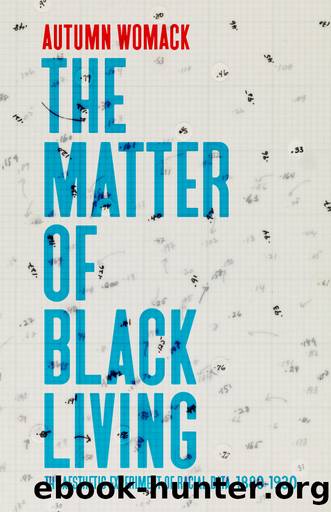The Matter of Black Living by Autumn Womack;

Author:Autumn Womack; [Womack, Autumn]
Language: eng
Format: epub
Tags: SOC000000 Social Science / General, SOC001000 Social Science / Ethnic Studies / African American Studies, HIS036060 History / United States / 20th Century, SOC052000 Social Science / Media Studies
Publisher: University of Chicago Press
Published: 2022-02-25T00:00:00+00:00
Figure 2.2 Sketch of the Baker family and the accompanying article describing their journey north, Boston Herald, July 19, 1899
The incongruence between the visual depiction of exemplary domesticity and the textual narrative of familial crisis is important here. Absent the specter of poverty and lynching, the image recalls a pre-lynching iteration of intact domesticity while looking forward to the reconstituted kinship that Jewettâs efforts promised to deliver. Together, Jewettâs plan for domestic rehabilitation and the line drawing recall the work of nineteenth-century educational reformers who, as Laura Wexler has argued, capitalized on the appeal of the âbefore and afterâ model to advertise the efficacy of reformersâ intervention and Indigenous peoplesâ capacity to be civilized.81 Rather than marshaling the visual pairing to course correct a path that was believed to be incapable of ever reaching industrialized civilization, Jewett evoked the paradigm to index a not-too-distant past that she could help retrieve. Within this new temporal economy, the âafterâ image registers a time before the before. A special dispatch from her personal journalist Mr. Larsen added additional fuel to the temporal crosshatch. In his account of the Bakersâ presence at the train station where they would commence their journey to Boston, Larsen simultaneously conveyed the transformative work that Jewett had already begun while suggesting that the Bakersâ current condition was a welcome return to prior domestic bliss: âThey were all very black and of slight build, and as they sat there were very different from what they were when Miss Jewett visited the little ramshackle cottage on the outskirts of the city the day before. At that time the trousers of the boys were out at the knees and were supported by one suspender.â In contrast to the scene of domestic havoc that Jewett supposedly encountered, after embracing Jewettâs offer, the Bakers, Larsen reported, are ârigged out in new clothing, furnished though the generosity of Miss Jewett and the Bakers are all well and happy.â82
The dissonance between image and the textâthat is, between the visual register of domestic idealism and the narrative description of familial precarityâbegins the temporal deferral that would ultimately recalibrate the binarism separating living and dead, evidentiary and live, and past and present, all of which the exhibit would come to both exploit and manage. And just as the sketch heralds a past moment while calling forth an unrealized future, it would also turn out to be a preenactment of the exhibit itself and ultimately the photographic portraits. But even before the Bakers emerged on stage, the line drawing was picked up by press outlets as the exhibitâs official iconography, creating an additional temporal rerouting. On July 23, the Boston Post printed a sketch nearly identical to the image that had appeared in the Boston Herald a week earlier (fig. 2.3). What interests me here is the way in which a temporal crisscrossing gets sewn into the Baker Exhibitâs fabric, which ultimately provides the occasion for both performative irruptions and political reordering.
Download
This site does not store any files on its server. We only index and link to content provided by other sites. Please contact the content providers to delete copyright contents if any and email us, we'll remove relevant links or contents immediately.
4 3 2 1: A Novel by Paul Auster(11788)
The handmaid's tale by Margaret Atwood(7448)
Giovanni's Room by James Baldwin(6809)
Asking the Right Questions: A Guide to Critical Thinking by M. Neil Browne & Stuart M. Keeley(5356)
Big Magic: Creative Living Beyond Fear by Elizabeth Gilbert(5352)
Ego Is the Enemy by Ryan Holiday(4957)
On Writing A Memoir of the Craft by Stephen King(4662)
The Body: A Guide for Occupants by Bill Bryson(4583)
Ken Follett - World without end by Ken Follett(4443)
Bluets by Maggie Nelson(4261)
Adulting by Kelly Williams Brown(4232)
Eat That Frog! by Brian Tracy(4149)
Guilty Pleasures by Laurell K Hamilton(4116)
White Noise - A Novel by Don DeLillo(3829)
The Poetry of Pablo Neruda by Pablo Neruda(3815)
Fingerprints of the Gods by Graham Hancock(3738)
Alive: The Story of the Andes Survivors by Piers Paul Read(3730)
The Book of Joy by Dalai Lama(3697)
The Bookshop by Penelope Fitzgerald(3619)
